Cameras still act like they’re living in 2008: closed boxes that capture files and little else. Meanwhile, smartphones became cultural powerhouses by embracing apps, and the gap is only getting wider.
Smartphones changed what photography means, and not in a subtle way. They didn’t just put decent cameras in everyone’s pocket. They redefined the act of taking a picture into a continuous cycle of capture, edit, and publish, all contained in a single device. That shift was powered less by the camera hardware itself and more by the app ecosystems that surrounded it. Editing apps, social networks, AI-powered filters, and cloud storage created an environment where photography wasn’t just about making images, but about instantly doing something with them. By contrast, dedicated cameras remain stubbornly closed. Even in 2025, the core experience is the same as it was a decade ago: capture files, transfer them awkwardly to another device, and only then begin to work with them. The cameras themselves are static boxes, immune to the creative vibrancy that apps bring to phones.
That gap might have been tolerable when the primary market for cameras was professionals and hardcore enthusiasts, people who expected to spend hours at a computer fine-tuning raw files. But the cultural ground has shifted. Many people taking pictures today began their photography lives with smartphones, where speed and fluidity were built into the experience from day one. They are accustomed to tapping a screen, sliding a few filters, and sharing to the world instantly. For them, the idea of buying a thousand-dollar camera only to discover that it makes their workflow slower feels like madness. In a landscape where immediacy, flexibility, and constant updates are the norm, dedicated cameras risk becoming relics unless they evolve into something more than isolated tools.
Smartphones Set the Standard
The iPhone didn’t become the most influential camera of all time simply because it had good lenses or clever sensors. What made it transformative was the convenience and the App Store, which gave developers a playground to build tools that extended the phone’s capabilities far beyond what Apple alone could imagine. Suddenly, your camera wasn’t just a camera; it was a portal to Snapseed for editing, Instagram for sharing, VSCO for filters, or Lightroom Mobile for professional-grade tweaks. That abundance of choice and flexibility is what made smartphones into true creative hubs. The hardware mattered, but the ecosystem turned the hardware into a lifestyle.
Over time, that model became not just attractive but expected. Young photographers growing up with phones never had to think about file transfers, card readers, or desktop workflows. They never had to wait until later to share what they just shot. To them, photography isn’t an isolated activity but a continuous loop, one where immediacy is baked into the process. That expectation bleeds into every corner of culture, from social media influencers who must post within minutes to journalists covering breaking news. Dedicated cameras may capture technically superior images, but if those images live in isolation until they can be transferred and processed, the cultural relevance is lost.
Cameras Are Still Stuck in the Past
Traditional camera makers, by contrast, still treat connectivity as a novelty rather than a necessity. Wi-Fi and Bluetooth are offered as features, but they are often poorly implemented, buried in confusing menus, and paired with smartphone apps that feel like afterthoughts. Transferring a handful of JPEGs to a phone can take longer than editing an entire TikTok clip. Firmware updates are infrequent, often limited to minor autofocus tweaks or bug fixes, and rarely add genuinely new features. Beyond that, the cameras are static: once you buy them, their capabilities are essentially frozen in time.
 For a smartphone user migrating to a mirrorless or DSLR, this is a jarring step backward. Imagine buying a sleek new camera and realizing that it slows you down compared to the phone already in your pocket. The very act of using it introduces friction into a workflow that used to be effortless. For enthusiasts, that friction is annoying. For casual users, it’s enough to make them abandon the camera entirely. And every year the gap widens, because smartphones keep improving at lightning pace while cameras creep forward in tiny increments. The problem isn’t just technological, it’s cultural: the industry still sees cameras as isolated tools, while the rest of the world has moved on to ecosystems.
For a smartphone user migrating to a mirrorless or DSLR, this is a jarring step backward. Imagine buying a sleek new camera and realizing that it slows you down compared to the phone already in your pocket. The very act of using it introduces friction into a workflow that used to be effortless. For enthusiasts, that friction is annoying. For casual users, it’s enough to make them abandon the camera entirely. And every year the gap widens, because smartphones keep improving at lightning pace while cameras creep forward in tiny increments. The problem isn’t just technological, it’s cultural: the industry still sees cameras as isolated tools, while the rest of the world has moved on to ecosystems.
The New Camera User
The demographics of camera buyers have shifted dramatically over the past decade. Gone are the days when most new photographers cut their teeth on film or entry-level DSLRs. Today’s buyers are far more likely to come from smartphones, and they carry with them the habits and expectations shaped by that environment. They aren’t used to waiting, exporting, or batch processing. They expect their camera to behave like a phone: immediate, connected, and frictionless. When those expectations aren’t met, the experience feels broken.
Even professionals are not immune to these pressures. In sports, news, and event photography, the ability to publish quickly can matter as much as the quality of the shot. Wire services demand immediacy, and editors want images delivered while the event is still happening. A camera that allowed for in-device editing and direct publishing could transform those workflows. Instead, professionals rely on cumbersome FTP setups, tethered laptops, or assistants rushing memory cards back and forth. The irony is that both casual users and working pros are pushing for the same thing: speed. Cameras that can’t adapt to that demand risk being left behind by both ends of the market.
The Promise of a Camera Ecosystem
So what would it look like if cameras actually embraced ecosystems? Imagine an app marketplace built into your Sony, Canon, or Nikon body. Third-party developers could create custom film simulations, LUTs, or filter packs tailored for different shooting styles. Computational modules could add AI-powered noise reduction, HDR stacking, or portrait enhancements directly in-camera. A social media app could let you capture, edit, and post to Instagram or TikTok without ever leaving the device. For professionals, specialized apps could handle metadata tagging, tethered workflow customization, or even niche tools like astrophotography stacking.
 The impact would be more than functional; it would be cultural. A thriving app ecosystem would make cameras feel dynamic, alive, and customizable. They would stop being static objects that slowly become obsolete and instead become platforms that grow with their users. That growth would encourage people to invest, not just in the hardware, but in the community and the culture around it. The same way that iPhones became lifestyle hubs, cameras could reclaim cultural relevance by offering flexibility and creativity baked into the device itself.
The impact would be more than functional; it would be cultural. A thriving app ecosystem would make cameras feel dynamic, alive, and customizable. They would stop being static objects that slowly become obsolete and instead become platforms that grow with their users. That growth would encourage people to invest, not just in the hardware, but in the community and the culture around it. The same way that iPhones became lifestyle hubs, cameras could reclaim cultural relevance by offering flexibility and creativity baked into the device itself.
The Developer Dilemma
Of course, opening cameras to apps doesn’t automatically mean developers will flock to them. The reason the iPhone App Store exploded was scale. Billions of potential users guaranteed that even niche apps could find an audience large enough to be profitable. Cameras, by contrast, sell in the low millions globally each year. From a developer’s perspective, that’s a rounding error compared to the smartphone market. Why spend months building a noise reduction plug-in for Sony cameras when you could build a mobile app that instantly reaches tens of millions of people?
This is the core dilemma. Without enough users, ecosystems risk becoming ghost towns. The only way to overcome that is with deliberate effort from camera makers themselves. They would need to offer incentives like revenue-sharing programs, development kits that simplify porting from existing platforms, or subsidies that seed the ecosystem until it gains traction. They might also lean on cross-platform frameworks that allow apps to run on both cameras and phones, increasing the potential market. Without these steps, the dream of a vibrant camera app store will remain a fantasy, no matter how much sense it makes in theory.
Lessons From Other Industries
History is full of examples that show ecosystems can transform hardware categories. Apple’s App Store turned the iPhone from a niche gadget into a cultural powerhouse by giving developers a reason to invest. DJI drones gained staying power by tying their hardware to apps that made flying intuitive and editing seamless. GoPro carved out a niche by integrating tightly with mobile software, ensuring that action cameras weren’t just about capture but also about sharing. Even gaming consoles, which sell in the tens of millions rather than billions, sustain thriving ecosystems because the communities are strong and the tools compelling.
Cameras are not inherently different. They just suffer from inertia and conservatism. Manufacturers fear losing control, so they wall off their systems. But if drones, action cams, and game consoles can sustain ecosystems with smaller audiences, there’s no reason cameras couldn’t as well — if the will existed. What’s missing is vision, not feasibility. The companies have the technology, but not the mindset to embrace openness.
The Risks of Staying Closed
The alternative is grim but predictable. Cameras remain what they are today: specialist tools for enthusiasts and professionals, culturally irrelevant to everyone else. Migrating smartphone users will try them, hit the wall of friction, and retreat back to their phones. Professionals will keep relying on clunky workarounds, leaving cameras themselves feeling like frozen relics. Meanwhile, phones will keep sprinting ahead with computational tricks, AI enhancements, and frictionless workflows that make dedicated cameras look increasingly outdated.
The danger isn’t extinction. Cameras will always have a niche. The danger is irrelevance. A closed system ensures cameras will remain on the margins, admired by specialists but ignored by the broader culture. They will become like high-end audio gear or mechanical watches: respected, even loved, but fundamentally separate from mainstream life. That might be acceptable for some manufacturers, but it’s a huge cultural loss for photography as a whole.
Conclusion: Platform or Niche?
The camera industry faces a crossroads. It can remain closed, continuing to make static boxes that capture excellent images but frustrate users with outdated workflows. Or it can take the leap into ecosystems, transforming cameras into platforms that evolve with their users. Doing so won’t be easy. The scale problem is real, and developers won’t line up without incentives. But history shows that ecosystems can flourish in smaller markets if the tools and communities are compelling enough.
In a world where immediacy, editing, and publishing matter as much as capture itself, a camera without an ecosystem is already behind the curve. If manufacturers cling to their closed systems, cameras will shrink into irrelevance, surviving only as niche tools. If they open up, they have the chance to reclaim cultural relevance and become everyday creative platforms again. The choice will determine whether cameras remain artifacts of the past or evolve into essential tools of the future.








